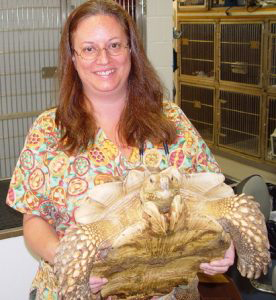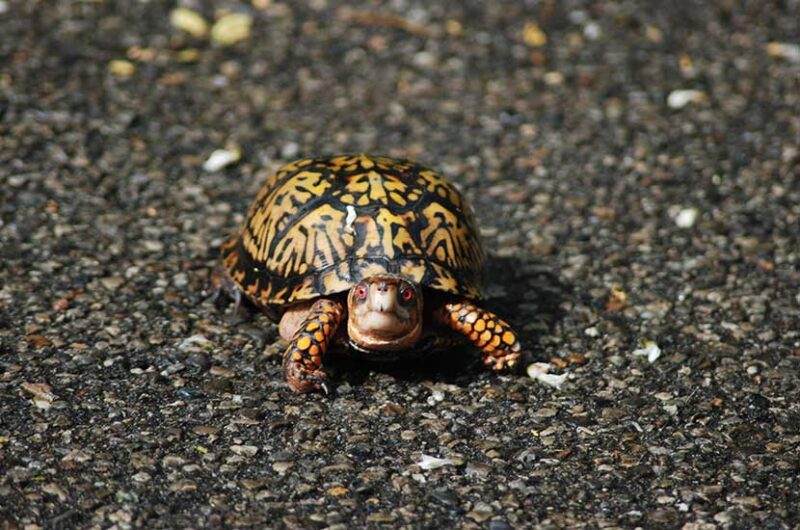By Phillippe De Vosjoli
Photos and edited by Susan Horton, DVM
 Husbandry factors are a common cause of many of the health problems affecting tortoises. Addressing husbandry issues is a critical component of the veterinary treatment of these popular animals.
Husbandry factors are a common cause of many of the health problems affecting tortoises. Addressing husbandry issues is a critical component of the veterinary treatment of these popular animals.Tortoises are members of the turtle family Testudinidae. Because of their mechanical-toy appearance, docility and endearing faces, tortoises remain among the most popular of all reptile pets. Thousands of imports and captive-bred tortoises are now sold annually in the pet trade, often to buyers who are uninformed about husbandry requirements. As a result, tortoises are among the reptiles most commonly seen by veterinarians.
Special Features
Tortoises have taken a unique evolutionary path. The normal defense of flight or aggression adopted by most reptiles has been replaced by the evolution of armor in the form of a shell. The tortoise shell (a vertebrate exoskeleton) has a compact rounded form with a low relative surface-to-volume ratio. What the implications? The shell offers minimal surface exposure to predators. Moreover, in terms of thermoregulation, heat once stored is retained for a long time. A tortoise that has been out basking may feel warm hours later as it rests in the insulating confines of its shelter. Because up to 50% of a tortoise’s weight (more in the case of thin animals) can consist of shell that is mostly skeleton, there are few species in which the effects of a multifactorial model of herpetoculture can be more easily observed.
Depending on how tortoises are raised, you will see in the course of their development differences in shell-to-body ratios and variations in shell, beak and nail growth. It should come as no surprise that various deformities and related health problems are common in captive-raised tortoises.
Selection
If one excludes the small numbers of rarer tortoises bred by specialists, the tortoise species sold in greatest numbers to the general public are the African spurred tortoise, the Leopard tortoise (now bred by the thousands annually) and the Russian tortoise, which is still imported by the thousands from Russia . Smaller numbers of Forest Hingeback tortoises are also imported for the general pet trade.
As a rule, the smaller species, particularly the Russian and Greek tortoises, are better choices as pets than the large tropical species, which will eventually require either outdoor pens (in warmer areas) or room-sized enclosures and expensive heating and lighting. Some species of tropical tortoises, such as the South American red-footed and yellow-footed tortoise, are especially suited for areas with a high relative humidity (70%+).
Housing
Except for juveniles up to 4″ long (which can initially be raised in tanks 36-48″ long), tortoises should be kept in sizeable pens, at least 12 ft square and preferably 24 ft square for smaller species. Their need for space makes many species unsuitable as long-term indoor pets. Larger species, such as African spurred and leopard tortoises, can exceed 60 pounds (e.g., 200 pounds for a very large African spurred) and require pens at least 16′ x 8′ for smaller animals and 16′ x 16′ for larger ones. If kept indoors, these tortoises will require room-sized enclosures that will be challenging to maintain.
Landscaping outdoor enclosures
All tortoises require shelter in order to feel secure and be free of the debilitating effects of chronic stress. Many keepers construct wood shelters for large species. Small dog houses or half-houses such as the plastic types with a top and snap-on bottom, can be provided for smaller species.
Other keepers successfully use clay flower pots placed on their sides and half buried in substrate. In addition, shelter and shade for savannah species, such as African spurred and Leopard tortoises, should be provided by shrubs or large grasses. Tortoises especially prefer shelters that lightly brush along the top of the carapace (top shell) when entered. The touch likely simulates that of foliage in the wild and can imitated with burlap, cloth or plastic, dried foliage or (if not eaten) artificial plants.
Leopard and Marginated tortoises have a domed shell that differs from the broad, dorso-ventrally flattened shell of the Gopher, Russian and African spurred tortoises. The latter are typically burrowers and ideally should be provided with enough substrate in which to construct burrows. An alternative is to dig hollows in the ground and cover them with wooden boards. Burrowing tortoises will choose to hide under the wood.
Temperature
As with other reptiles, providing the optimal temperature range for thermo-regulation is critical for the welfare of tortoises. Failure to provide adequate heat is a key factor in many diseases of these animals, including acute problems (such as life-threatening respiratory infections) and chronic disorders (such as shell deformities).
During warm months with daytime temperatures of greater than 75 degrees F (24 degrees C), tortoises placed in outdoor thermoregulate without the expense of spotlights and other heating devices. When housed indoors, tortoises should be offered a basking site under spotlights that can create a spot temperature of 85-90 degrees F (30-33 degrees C). All heat sources should be limited to only a portion of the enclosure. Ideally, both a thermometer and thermostat should be used to regulate the temperature at the basking site. The rest of the enclosure should be maintained at an ambient temperature to allow the tortoise to thermoregulate by moving between heated and unheated areas.
Outdoors, cooler areas are provided by shade and shelter. Providing heat for adults of large species of tortoises (as with other large reptiles) can be problematic and costly. To complicate matters, failure to provide appropriate cool spots can be fatal to certain species, such as the rarer Burmese and Bowsprit tortoises, so reference texts on specific species requirements should always be consulted when caring for tortoises.
Brumation (Hibernation) for the advanced keeper
Mediterranean species should be allowed to brumate at cooler temperatures for a few months. In areas of the U.S. with mild winters, these species can brumate in an unheated room of a house. Owners should consult texts that provide information on techniques to offer these species a cool rest period.
(For more guidelines on brumation, please refer to “Safer Hibernation and Your Tortoise” by Andy C. Highfield at www.tortoisetrust.org/articles/safer.html)
Drinking Water
Clean water should be made available at all times in a shallow water container that allows the tortoise to drink by tipping its head down. A shallow (less than the height of the shell) water container needs to be buried in the substrate with the edge just above the surface or, if its depth is about equal to the thickness of the tortoise’s head, placed on the surface of the substrate.
Diet
Most tortoises are strict herbivores, and many are primarily grass-eaters. In a sense, they are reptilian version of horses or guinea pigs, because they use hindgut fermentation to digest fiber. In captivity, most tortoises should be allowed to graze on grasses and weeds whenever possible. In addition, or as an alternative, various greens such as romaine lettuce, collard greens, mustard greens and dandelion may be fed routinely. Tortoises also like vegetables such as green beans, zucchini and other squashes. Tortoises consider red and orange fruit a treat, and these can be offered to constitute up to 5-10 % of the diet for savannah species and 25-30 % of the diet for tropical species (such as red-footed and Burmese). Mango, papaya, banana, cantaloupe, strawberries and watermelon are favorites.
The tropical species will eat small amounts of meat and invertebrates when available and can be offered pinky mice, slugs and nightcrawlers 3-4 weeks. Small African spurred tortoises kept outside in California relish any snails they can find. Many of the African species are programmed to eat white objects (calcium-rich bone fragments and snail shells in their native savannah) and ingest crushed cuttlebone and other calcium sources or white foreign bodies in captivity.
Fiber intake is critical for herbivores. All should be fed fiber sources such as grasses and browse when outdoors and grass hays (chopped or long-stem) when indoors.
Most diets of fresh graze or produce require supplementation with calcium, at a level of 1-2% of dry intake. Additions of calcium carbonate are needed for salads of commercial produce. Commercial pelleted diets sold in the pet trade have been fed successfully by some breeders when part of a diet that includes fresh graze, browse and produce. A potentially serious problem with commercial pellets is that they have low water content, and tortoises rely on adequate water intake (from food and drinking) for renal function. Diets of pellets exclusively risk dehydration.
Soaking
All tortoises benefit from a weekly soak of 30-60 minutes in shallow warm water. Many tortoises seem to be hard-wired to drink, urinate and defecate only when soaked. In these individuals, failure to drink from a container within a habitat should not be perceived as a lack of thirst or absence of dehydration. Tortoises fed dry commercial pellets should be soaked daily. Species from humid areas (such as red-footed and yellow-footed tortoises) should be soaked at least once weekly and also have water available in their habitats. All hatchings, as well as sick tortoises, should be soaked daily. Rescues, new imports and dehydrated patients passing visible white precipitated urates benefit from soaks twice daily.
Sources and Recommended Readings
If you have any questions, please feel free to call us at (502) 241-4117.


